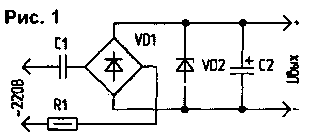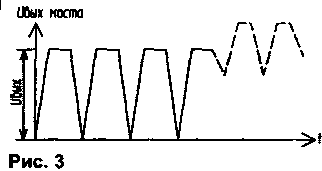
|
|
ENCYCLOPEDIA OF RADIO ELECTRONICS AND ELECTRICAL ENGINEERING Adjustment of Uout of a transformerless power supply. Encyclopedia of radio electronics and electrical engineering
Encyclopedia of radio electronics and electrical engineering / Regulators of current, voltage, power Known to readers [1...5] transformerless power supplies with a quenching capacitor (BPGC) (Fig. 1) have a significant drawback - the inability to smoothly adjust the output voltage. Its value is always fixed and is uniquely determined by the stabilization voltage of the applied zener diode, and it cannot be changed smoothly. In many cases, such an adjustment is necessary.
I offer BPGC, which allows you to smoothly change the output voltage over a wide range (Fig. 2). Its feature is the use of adjustable negative feedback from the output of the block to the transistor stage VT1, connected in parallel with the output of the diode bridge. This stage is a parallel control element and is controlled by a signal from the output of a single-stage amplifier to VT2. The output signal VT2 depends on the voltage difference supplied from the variable resistor R7, connected in parallel to the output of the power supply, and the reference voltage source on the diodes VD3, VD4. Essentially, this circuit is an adjustable shunt regulator. The role of the ballast resistor is played by the quenching capacitor C1, the role of the parallel controlled element is played by the transistor VT1. This power supply works as follows. When connected to the network, the transistors VT1 and VT2 are locked, the storage capacitor C2 is charged through the diode VD2. When the base of the transistor VT2 reaches a voltage equal to the reference voltage on the diodes VD3, VD4, the transistors VT2, VT1 begin to unlock. Transistor VT1 shunts the output of the diode bridge, and its output voltage begins to drop, which leads to a decrease in the voltage on the storage capacitor C2 and to blocking of transistors VT2 and VT1. This, in turn, causes a decrease in shunting of the output of the diode bridge, an increase in the voltage on C2 and unlocking of VT2, VT1, etc. Due to the negative feedback acting in this way, the output voltage remains constant (stabilized) with and without the load R9 on, at idle. Its value depends on the position of the R7 potentiometer slider. The upper (according to the diagram) position of the slider corresponds to a higher output voltage. The maximum output power of the above device is 2 watts. The output voltage adjustment limits are from 16 V to 26 V, and with a shorted VD4 diode, the adjustment limits are from 15 V to 19,5 V. In these ranges, when R9 is turned off (load shed), the increase in output voltage does not exceed one percent. The power supply according to the scheme of Fig. 2 is not afraid of a short circuit of the load. Transistor VT1 operates in variable mode: when working on load R9 - in linear mode, at idle - in pulse-width modulation (PWM) mode with a voltage ripple frequency across capacitor C2 - 100 Hz. In this case, the voltage pulses on the collector of the transistor VT1 have gentle fronts. The linear mode is lightweight, the VT1 transistor heats up a little and can work with little or no heatsink. A slight heating takes place in the lower position of the R7 potentiometer slider at the minimum output voltage. At idle, with the load R9 off, the thermal regime of the transistor VT1 worsens in the upper position of the R7 engine. In this case, the transistor VT1 must be installed on a small radiator, for example, in the form of a square-shaped aluminum plate with a side of 3 cm, 1 ... 2 mm thick. Regulating transistor VT1 - medium power, with a large transfer coefficient (composite). Its collector current should be 2...3 times the maximum load current. The collector voltage VT1 must not be less than the maximum output voltage of the power supply. As VT1, npn transistors KT972A, KT829A, KT827A, etc. can be used. Transistor VT2 operates in low current mode, so any low-power pnp transistor is suitable - KT203A ... V, KT361A ... G, KT313A, B, KT209A, B, etc. The capacitance of the quenching capacitor C1 can be approximately determined by the methods [3, 5]. The criterion for the correct choice of capacitance C1 is to obtain the required maximum voltage at the load. If its capacitance is artificially reduced by 20 ... 30%, then the maximum output voltage at the rated load will not be provided. Another criterion for the correct choice of C1 is the invariance of the nature of the voltage waveform at the output of the diode bridge (Fig. 3). The voltage waveform has the form of a sequence of rectified sinusoidal half-waves of the mains voltage with limited (flattened) tops of positive half-sine waves. The amplitudes of the limited vertices are variable, depend on the position of the R7 potentiometer slider and change linearly as it rotates. But each half-wave must necessarily reach zero, the presence of a constant component (as shown in Fig. 3 by a dotted line) is not allowed, because in this case, the stabilization mode is violated.
The level of ripple at the load for the circuit in Fig. 2 is no more than 70 mV. Resistors R1, R2 are protective. They protect the control transistor VT1 from failure due to overcurrent during transients at the time the unit is connected to the network (due to the bounce of the contacts of the connecting pair of the mains plug-socket). According to the principle of the above scheme, similar power supplies can be built for other required power values. Literature
Author: N.Tsesaruk, Tula; Publication: N. Bolshakov, rf.atnn.ru
Machine for thinning flowers in gardens
02.05.2024 Advanced Infrared Microscope
02.05.2024 Air trap for insects
01.05.2024
▪ Music speakers LG XBoom XL7 and XL5 ▪ Good music promotes good teamwork
▪ section of the site Reference materials. Article selection ▪ article Girl with a paddle. Popular expression ▪ article What revolves around what: the Earth around the Moon or vice versa? Detailed answer ▪ Grapefruit article. Legends, cultivation, methods of application ▪ article Ultrashortwave antennas. Encyclopedia of radio electronics and electrical engineering ▪ article Regenerative KB receiver. Encyclopedia of radio electronics and electrical engineering
Home page | Library | Articles | Website map | Site Reviews www.diagram.com.ua |






 Arabic
Arabic Bengali
Bengali Chinese
Chinese English
English French
French German
German Hebrew
Hebrew Hindi
Hindi Italian
Italian Japanese
Japanese Korean
Korean Malay
Malay Polish
Polish Portuguese
Portuguese Spanish
Spanish Turkish
Turkish Ukrainian
Ukrainian Vietnamese
Vietnamese



 Leave your comment on this article:
Leave your comment on this article: